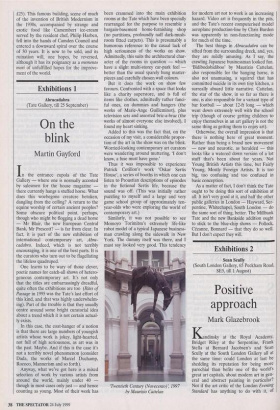Exhibitions 2
Sean Scully (South London Gallery, 65 Peckham Road, SE5, till 1 August)
Positive approach
Mark Glazebrook
Kndinsky at the Royal Academy, Bridget Riley at the Serpentine, Frank Stella at Bernard Jacobsen's and Sean Scully at the South London Gallery all at the same time: could London at last be shedding its reputation for being more parochial than befits one of the world's great art capitals, about modern art in gen- eral and abstract painting in particular? Not if the art critic of the London Evening Standard has anything to do with it, of course, but even he is caught up in the swell of interest, and gives useful publicity to the shows he loves to hate. There are now plenty of opportunities to acquire or develop a taste and a feeling for abstract painting. If current trends continue, and if education is enlightened, the day may come when its capacity to be as full of vari- ety as music, its neutrality as regards sub- ject matter, and its potential for creating unadulterated beauty will enable Abstrac- tion to succeed Impressionism as the big crowd-puller among movements in art.
If that day comes, Sean Scully, born in Ireland in 1945, educated in England, and now a well-travelled American citizen, whose record on the international exhibi- tion circuit is impressive, will be seen to deserve a place of honour. Perhaps his main claim to fame so far is that, having infiltrated himself into the Minimalist strongholds of New York, he then broke away by re-introducing a distinctive sort of measured passion to the art of painting. He has convincingly shown what an enormous variety of objects — his paintings are very much physical objects — can be created using a very limited compositional vocabu- lary. He continues to work purely with rect- angles of colour or 'stripes', having breathed new life into them when the whole genre of stripe painting began to look jaded or dated.
Early in his career, to give a more spiri- tual dimension to Action Painting he tried to synthesise elements from the work of Mondrian and Pollock. He has written a book on Rothko. His sense of colour is rich yet restrained and is rooted in a discrimi- nating love of great painting. Like Matisse he wants his paintings to make people feel positive about life, happy even, although they are never facile, and part of their beauty is in their hint of melancholy. He wants his work to reflect his own humanity.
His is the sort of painting that is greatly enhanced by being seen in a sympathetic space: and nestling next to Camberwell School of Art is the South London Gallery, which maintains a sort of friendly dignity, being spacious and well lit. If only the late 19th-century architects of the Whitechapel Gallery (where Scully had a solo show in 1989) and of the South London Gallery could have come back from the grave to advise the architects of the Hayward Gallery and the Barbican Gallery on how to combine subtlety and simplicity. The South London Gallery is one of the few exhibition spaces in London capable of showing very large paintings satisfactorily.
It so happens that Scully, who is a big man, has been painting on a very large scale recently. The marriage between artist and building is well consummated. Where- as Kandinsky's little pioneering water- colours at the Royal Academy impress by their originality and compositional inven- tiveness, Scully's big 'Walls of Light' and `Large Mirrors' create a special enveloping mood which gently but firmly makes its presence felt throughout the whole gallery, rather as good music does.
What is excitingly different about some of Scully's new paintings is that they appear to have been painted faster than previous- ly, and the spectator is pulled in to empathise with the process. These some- `Wall of Light Blue', 1999, by Sean Scully times breathtaking combinations of colour, balanced yet on the verge of imbalance, are not slapdash. On the contrary, there is that feeling of ease and confidence that comes with continual practice.



























































 Previous page
Previous page